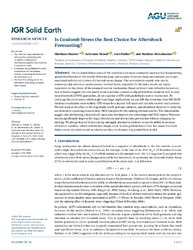Is Coulomb Stress the Best Choice for Aftershock Forecasting?
DOI: https://doi.org/10.1029/2020JB019553
Persistent URL: http://resolver.sub.uni-goettingen.de/purl?gldocs-11858/9458
Persistent URL: http://resolver.sub.uni-goettingen.de/purl?gldocs-11858/9458
Sharma, Shubham; Hainzl, Sebastian; Zöeller, Gert; Holschneider, Matthias, 2020: Is Coulomb Stress the Best Choice for Aftershock Forecasting?. In: Journal of Geophysical Research: Solid Earth, Band 125, 9, DOI: 10.1029/2020JB019553.
 |
Dokument öffnen: |
The Coulomb failure stress (CFS) criterion is the most commonly used method for predicting spatial distributions of aftershocks following large earthquakes. However, large uncertainties are always associated with the calculation of Coulomb stress change. The uncertainties mainly arise due to nonunique slip inversions and unknown receiver faults; especially for the latter, results are highly dependent on the choice of the assumed receiver mechanism. Based on binary tests (aftershocks yes/no), recent studies suggest that alternative stress quantities, a distance-slip probabilistic model as well as deep neural network (DNN) approaches, all are superior to CFS with predefined receiver mechanism. To challenge this conclusion, which might have large implications, we use 289 slip inversions from SRCMOD database to calculate more realistic CFS values for a layered half-space and variable receiver mechanisms. We also analyze the effect of the magnitude cutoff, grid size variation, and aftershock duration to verify the use of receiver operating characteristic (ROC) analysis for the ranking of stress metrics. The observations suggest that introducing a layered half-space does not improve the stress maps and ROC curves. However, results significantly improve for larger aftershocks and shorter time periods but without changing the ranking. We also go beyond binary testing and apply alternative statistics to test the ability to estimate aftershock numbers, which confirm that simple stress metrics perform better than the classic Coulomb failure stress calculations and are also better than the distance-slip probabilistic model.
Statistik:
ZugriffsstatistikSammlung:
This is an open access article under the terms of the Creative Commons Attribution License, which permits use, distribution and reproduction in any medium, provided the original work is properly cited.

